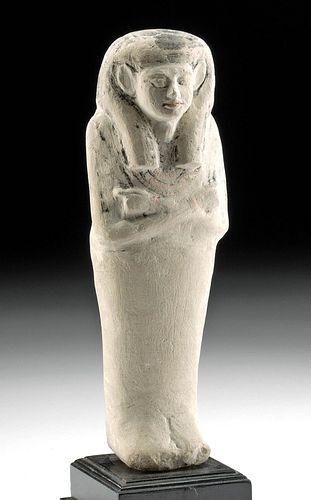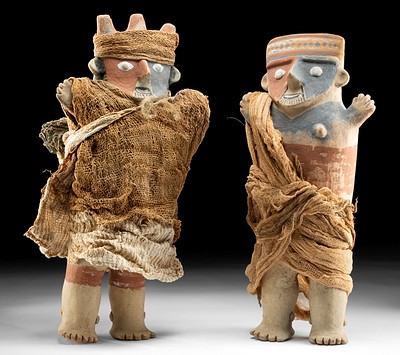Published Egyptian New Kingdom Limestone Ushabti
Lot 2
About Seller
Artemis Fine Arts
686 S Taylor Ave, Ste 106
Louisville, CO 80027
United States
Selling antiquities, ancient and ethnographic art online since 1993, Artemis Gallery specializes in Classical Antiquities (Egyptian, Greek, Roman, Near Eastern), Asian, Pre-Columbian, African / Tribal / Oceanographic art. Our extensive inventory includes pottery, stone, metal, wood, glass and textil...Read more
Estimate:
$5,000 - $7,500
Absentee vs Live bid
Two ways to bid:
- Leave a max absentee bid and the platform will bid on your behalf up to your maximum bid during the live auction.
- Bid live during the auction and your bids will be submitted real-time to the auctioneer.
Bid Increments
| Price | Bid Increment |
|---|---|
| $0 | $25 |
| $300 | $50 |
| $1,000 | $100 |
| $2,000 | $250 |
| $5,000 | $500 |
| $10,000 | $1,000 |
| $20,000 | $2,500 |
| $50,000 | $5,000 |
| $100,000 | $10,000 |
| $200,000 | $20,000 |
About Auction
By Artemis Fine Arts
May 19, 2022
Set Reminder
2022-05-19 10:00:00
2022-05-19 10:00:00
America/New_York
Bidsquare
Bidsquare : Fine Antiquities | Ethnographica | Fine Art
https://www.bidsquare.com/auctions/artemis-gallery/fine-antiquities-ethnographica-fine-art-9350
Featuring a very special collection of Fine Art from the Hollywood Hills, including Picasso & Rookwood ceramics! Also included are many fine examples of classical antiquities, ancient, and ethnographic art from cultures encompassing the globe. Artemis Fine Arts info@artemisfinearts.com
Featuring a very special collection of Fine Art from the Hollywood Hills, including Picasso & Rookwood ceramics! Also included are many fine examples of classical antiquities, ancient, and ethnographic art from cultures encompassing the globe. Artemis Fine Arts info@artemisfinearts.com
- Lot Description
Ancient Egypt, New Kingdom, 19th Dynasty, ca. 1292 to 1189 BCE. A gorgeous ushabti figure carved by hand from gray-white limestone exhibiting a slender form. The figure presents standing in mummiform with fused legs atop protruding feet while crossing both arms atop her chest. A pair of hoes painted in black extends from her hands, signifying her duty to tend the fields of Osiris in the afterlife, and a black seed bag is painted behind her right shoulder. Additional red pigment creates stripes bangles that adorn each wrist, the 'beaded' ornamentation of her elaborate wesekh broad collar, and the profile of her plump lips. Her haunting yet serene countenance stares outwards with almond-shaped eyes while slender brows and large, almost Hathoric ears further define her appearance, all framed within the thick lappets of her sizable wig. One can only imagine how intricate and colorful this artifact was when first created, and her beauty has endured through the millennia. Size: 2.6" W x 7.7" H (6.6 cm x 19.6 cm); 8.6" H (21.8 cm) on included custom stand.
Ushabti were first introduced in the Middle Kingdom as substitutes for the mummy in case it was destroyed. During the Second Intermediate Period inscribed wooden figures called shawabtis (after the Egyptian word for wood, shawab) began to be placed in tombs. During the New Kingdom, ushabti assumed a new role as servant figures for the deceased. They were now depicted with agricultural equipment. By the Third Intermediate Period, the number of shabti placed in the tomb was set at 401 (365 workers and 36 overseers). During the Late Period the tomb figures became known as ushabtis ('answerers'), these figures represented servants who would magically answer when called upon to perform agricultural duties for the Pharaoh (in the form of Osiris) in the afterlife. Their main function was to ensure the individual's comfort and freedom from daily labor in the next life.
Published in Eisenberg, J. "Art of the Ancient World." Vol. XXIX, New York, 2018, no. 138
Cf. The Metropolitan Museum of Art, accession number 86.1.23
Provenance: ex-Royal Athena Galleries, New York, New York, USA; ex-Drouot Hotel, Paris, France, May 2016; ex-private G.F. Burgh collection, The Hague, Netherlands, 1984
All items legal to buy/sell under U.S. Statute covering cultural patrimony Code 2600, CHAPTER 14, and are guaranteed to be as described or your money back.
A Certificate of Authenticity will accompany all winning bids.
PLEASE NOTE: Due to recent increases of shipments being seized by Australian & German customs (even for items with pre-UNESCO provenance), we will no longer ship most antiquities and ancient Chinese art to Australia & Germany. For categories of items that are acceptable to ship to Australia or Germany, please contact us directly or work with your local customs brokerage firm.
Display stands not described as included/custom in the item description are for photography purposes only and will not be included with the item upon shipping.
#171576Small losses to front of feet as shown. Large chips atop feet and along right buttock, with abrasions and fading to pigment, minor softening to some finer details, and light encrustations, otherwise in excellent condition. Lovely remains of black and red pigment across obverse, wig, and behind right shoulder, and wonderful preservation to overall form. Figure is attached and adhered to display stand and cannot be removed.Condition
- Shipping Info
-
All shipping is handled in-house for your convenience. Your invoice from Artemis Gallery will include shipping calculation instructions. If in doubt, please inquire BEFORE bidding for estimated shipping costs for individual items.
-
- Buyer's Premium



 EUR
EUR CAD
CAD AUD
AUD GBP
GBP MXN
MXN HKD
HKD CNY
CNY MYR
MYR SEK
SEK SGD
SGD CHF
CHF THB
THB













